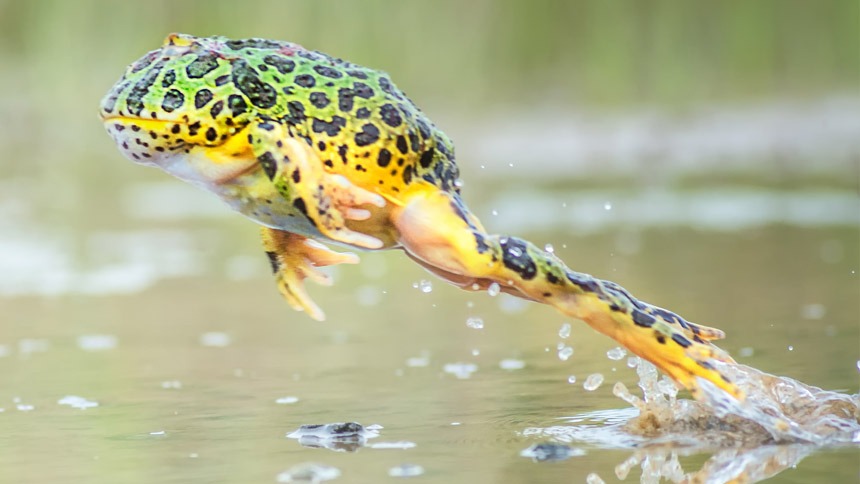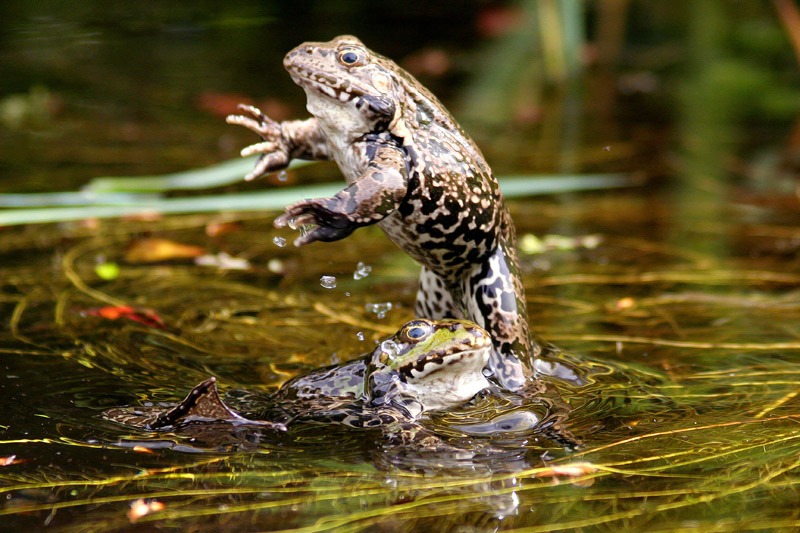
How High Can Frogs Jump?
Taking a stroll in the evening with my kid brother, a frog jumped out of the water suddenly and my brother was amazed at the sight of it and he immediately turned to me and asked me a question “do frogs always jump that high, or was that a coincidence?”.
This question left me stunned that I was unable to find a perfect answer to the question asked. Then I realized that I have never paid serious attention to how a frog jumps.
So when he asked the question and I couldn’t answer him, that prompted me to research it.
Page Contents
Frog Jump Height
How high a frog can jump depends on their kind, but all frogs can at least make a jump twice their height. I am old enough to know that at least. I grew up in an environment where we see frogs daily and the noise they make in the night is not something new to me.
Some species of frog are better jumpers and a typical example of that is the tree frog, they can jump 10 times their height. Smaller frogs are lighter and they tend to jump higher than the big ones.
Because they are light, it makes it easier to lift their body but this will be a bit difficult for the bigger ones because they are heavier.
Frog Jump Length
How far a frog jumps is greatly dependent on its skeletal structure or call it the structure of its body and this makes it either easier or harder to jump. A lot of frogs can make a jump 30 times their body length while the smaller tree frogs can make a jump 50 times their body length.
Interesting: Some frogs have webbed toes and they use these as parachutes to reduce the speed of their fall and move effortlessly from one thing to another.
How Frogs Jump
People think that the stronger the leg muscle of a frog the higher the jump. They think that the leg muscle enhances the jump. This is a wrong perception because the leg muscle plays little or no role in making a high or far jump.
The tendons are the secret to frogs jump. Their tendons expand when the frog is getting ready to make a jump and while this is happening, the leg muscles reduce and then pass energy to the tendons.

A frog makes a jump immediately when the energy is passed and the tendons fall to their original position.
Researchers have made findings over the last years to find out how frogs jump as high and far as they do. Henry Astley, one of the researchers finally got the answer.
He and this colleague filmed a frog at 500 frames per second in other to know how a frog jumps. They didn’t stop there, they continued by filming the frog using the x-ray camera and this enabled them to discover that the tendons are important to the jump of the frog.
It is to be noted that almost a quarter of a frog’s weight is in its leg and this enables them to jump the way they do.
FAQs Section
Answers to some of the most common questions about a frog’s jump.
Frogs hop when they move with light bounding or leap and to know which frogs hop or jump we need to be informed that there are two kinds of frog in terms of the length of the leg. We have the long-legged frogs and the short-legged frogs.
Long-legged frogs make a jump. They cover long distances due to the length of their leg. Because they can cover a long distance, it becomes easier to escape danger and get to safety.
Short-legged frogs, mostly toads, due to the length of their leg, cannot cover a long distance. So instead, they hop and this activity covers a short distance. They are more vulnerable to attack because they can only cover short distances.
Yes, a frog can jump out of water. I have personal experience. It was an amazing view especially when it catches you off guard. You will be startled at first but then you smile after. It was this experience that made me venture into this research. Frogs don’t just jump out of water for fun or no reason, they jump out of water for a purpose and one of which is to chase down their victim or target.
Photo by: Isabelle Barthe, Adobe Stock
To every activity of man and animal, there is a reason, a purpose, and a cause and effect relationship. Birds do not fly just for fun, a rooster does not crow for no reason.
Survival instinct is not just found in man but also in all living creatures. Most frogs jump for safety reasons, some can jump pretty far, frogs aren’t good at walking. Frogs jump because it is easier to get away from dangers while jumping compared to when walking. The species that can jump farther and higher have a tendency to get away from predators than the frogs/toads that hop.
When threatened, frogs don’t just jump to get to safety, they decide means of escaping, a means of getting to safety easier. When a frog is being attacked, they jump away, stretching their legs out exposing the bright flash color. This color grabs the attention of the predator in pursuit, making the predator focus more on the color but then unexpectedly the color vanishes when the frog reaches the ground and folds its leg. This may confuse the part of the predator and this confusion is enough to buy enough time for the frog’s escape.
The answer to this question can not be easily captured in a single sentence because the movement of frogs differs. This is greatly dependent on their capability. For instance, toads generally and often move by making use of short hops and crawling.
But this is a different case when we are talking about flying tree frogs. They also are referred to as gliding frogs. A gliding grid can attain a gliding flight. It can descend at an angle less than 45 degrees relative to horizontal.
When moving from one place to another, they spread out their webbed feet and, as well as special flaps of skin on their legs and arms. This flying frog climbs up to 40 or 50 feet and then glides down stage by stage. We can look at the movement of frogs from two different situations or aspects.
First, when the frog is in the water and there is a need to swim. Second, when the frog is on land and needs to move from one place to another.
Frogs are swift in water and on land. That is, they tend to move faster and better in water than they do on land. Burrowing species, like many toads or Pacman Frogs, have short, squatty hind legs. But all other kinds of frogs have a long, mighty hind leg which is paramount for jumping. It’s feasible for many frogs to make a jump 20 times their body on a flat surface.
Frogs also have the capacity to swim with their hind legs. Like most aquatic animals, a frog possesses web toes on its hind feet. A frog’s webbed feet are an important feature when it comes to swimming, the webbed toe helps in swift swimming. Without these webbed toes, it will be almost impossible for frogs to swim. The smaller forearms support a frog when sitting. The front legs also help break the animal’s fall when it jumps.
Conclusion
Anurans (Frogs and Toads) have the capacity to move on land and water. On land, however, they’re capable of jumping to great heights and lengths. Some species are capable of jumping up to 50x their own length.
Toads, on the other hand, aren’t so gifting at jumping. They hop, essentially. Don’t let that fool you though; they’re pretty quick!
The current world record, at the time of writing this, is held by “Rosie the Ribiter”. Rosie leapt and astonishing 23 feet 5 & 3/4 inches!

Leave a Reply